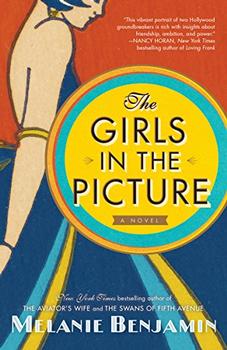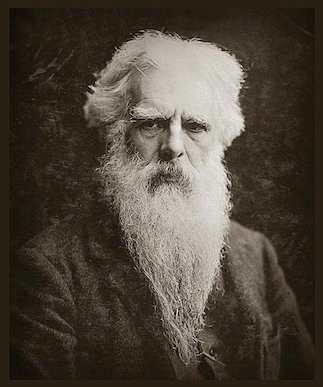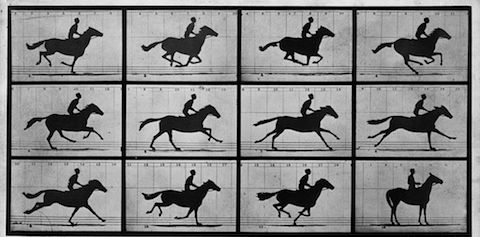Summary | Excerpt | Reading Guide | Reviews | Beyond the Book | Read-Alikes | Genres & Themes | Author Bio

Critics' Opinion:
Readers' Opinion:
First Published:
Jan 2018, 448 pages
Paperback:
Jan 2019, 464 pages
 Book Reviewed by:
Book Reviewed by:
Donna Chavez
Buy This Book
This article relates to The Girls in the Picture
Although the main characters in Melanie Benjamin's historical novel The Girls in the Picture are just breaking into the nascent film industry in the early 1900s, actual moving pictures had been around for decades. It all began in the United States, shortly after the American Civil War.
Eadweard Muybridge
 In the early 1870s, British born Eadweard Muybridge – a.k.a. Eadweard "Helios," Ted Muggeridge, Muygridge or E.J. Muggridge – then living in the States, was busy experimenting with the fascinating new art of photography. Described as solitary, peripatetic, unpredictable and nervous, Muybridge attracted the attention of staid, shrewd and ruthless California businessman Leland Stanford. The former California governor and founder of Stanford University also raised racehorses. One legend (for what legends are worth) has it that Stanford had a bet with an associate that in the course of their stride, at one point horses had all four hooves off the ground. Of course this was preposterous. Observers could see with their own eyes that this was impossible.
In the early 1870s, British born Eadweard Muybridge – a.k.a. Eadweard "Helios," Ted Muggeridge, Muygridge or E.J. Muggridge – then living in the States, was busy experimenting with the fascinating new art of photography. Described as solitary, peripatetic, unpredictable and nervous, Muybridge attracted the attention of staid, shrewd and ruthless California businessman Leland Stanford. The former California governor and founder of Stanford University also raised racehorses. One legend (for what legends are worth) has it that Stanford had a bet with an associate that in the course of their stride, at one point horses had all four hooves off the ground. Of course this was preposterous. Observers could see with their own eyes that this was impossible.
 So Stanford presented the dilemma to Muybridge, laying resolution of the question in his lap. According to an
So Stanford presented the dilemma to Muybridge, laying resolution of the question in his lap. According to an
Word spread, crisscrossing the ocean as one inventor after another stayed up nights working out how to replace Muybridge's unwieldy multi-camera system with a single camera that could capture multiple pictures in sufficiently quick succession to appear as if they were moving. Men with familiar names such as Thomas Edison, Auguste and Louis Lumière, Georges Méliès, George Eastman and many more, each working on his aspect of the challenge to improve equipment for filming and replaying moving pictures, advanced the technique and equipment from Muybridge's cumbersome beginning. Key words here are technique and equipment. The art of film-making was yet to enter the picture.
Up until the 1890s the new medium mainly produced depictions of things in motion – horses, birds, and people walking, dancing or performing magic tricks – filmed from a single camera angle. But in 1896, Méliès is credited with creating the first movies with a narrative. From there motion pictures began to soar in popularity. Because, as Fran Marion says in The Girls in the Picture, "I glanced around at the audience, people just like me – lost, lonely people, perhaps, or maybe housewives who'd just dropped in after shopping because they didn't want to go to their chores or their children. Or husbands putting off going home to nagging wives...And together we were all staring rapturously at the screen, laughing, poking one another in the side, forgetting about the outside world and our troubles and disappointments – all because of these movies."
Georges Méliès' famous 1902 silent science fiction film, A Trip to the Moon:
The Horse in Motion (1878)
The Horse in Motion by Eadweard Muybridge: The horse, Sallie Gardner, owned by Leland Stanford, running at a 1:40 pace over the Palo Alto track, June 19, 1878.
Filed under Medicine, Science and Tech
![]() This "beyond the book article" relates to The Girls in the Picture. It originally ran in March 2018 and has been updated for the
January 2019 paperback edition.
Go to magazine.
This "beyond the book article" relates to The Girls in the Picture. It originally ran in March 2018 and has been updated for the
January 2019 paperback edition.
Go to magazine.





The Flower Sisters
by Michelle Collins Anderson
From the new Fannie Flagg of the Ozarks, a richly-woven story of family, forgiveness, and reinvention.

The House on Biscayne Bay
by Chanel Cleeton
As death stalks a gothic mansion in Miami, the lives of two women intertwine as the past and present collide.

The Funeral Cryer by Wenyan Lu
Debut novelist Wenyan Lu brings us this witty yet profound story about one woman's midlife reawakening in contemporary rural China.
Your guide toexceptional books
BookBrowse seeks out and recommends the best in contemporary fiction and nonfiction—books that not only engage and entertain but also deepen our understanding of ourselves and the world around us.